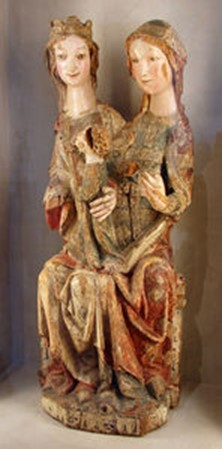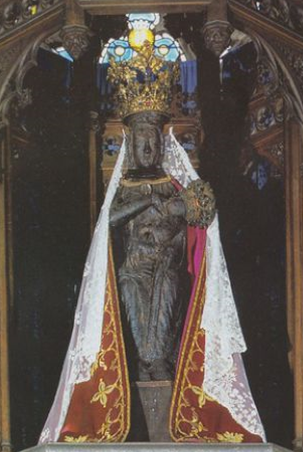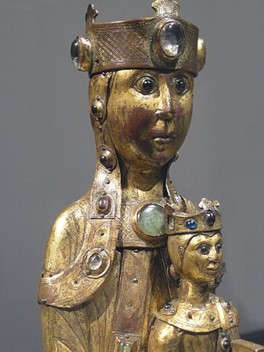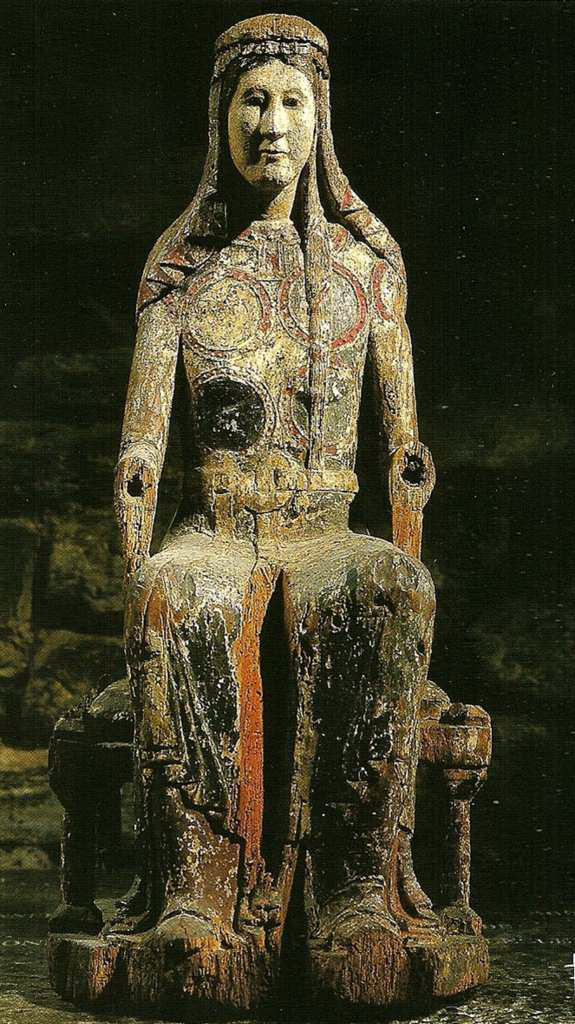
A rare two headed statue of two women in one sculpture (maybe a Black Madonna). Documentation states that it is St Anne Trinitarian.
She is made of pine, and is currently in a museum of Lyon, France from the church of Polignac.
Source: Lieux Sacres

This virgin is Our Lady the Black Virgin of Halle. She is a ‘Virgo Lactans’ – a nursing-type Black Virgin feeding her child. This was originally was banned by the church.
Onze Leive, Halle, Belgium
Source: Open Churches

Virgin and Child, held in the Metropolitan of Art in New York. She was made in Limoges, France in 1200 CE.
The child looks like the mother and is gilt copper champleve enamel with crystal and glass cabochons.
Champlevé is an enamelling technique in which cells are carved into the surface of a metal object and filled with vitreous enamel.
Source: Pinterest

This method often get mistaken for Cloisonne enamel, where metal strips added to the object and filled.
Source: Chairish.com
The Champlevé technique of enamel work has been used since ancient times in covering large piece. A wonderful example of this is the Black Virgin called the Lady in Full Light form Limoges 2009 CE pictured above.
This method has also been used in Celtic art to make geometric designs and in Romanesque art to make caskets, goblets, and plates.
Objects found in archaeology sites started as small pieces of jewellery with dates to around 3rd century BCE, and very rarely were any pieces found with any other colour than red.

Pictured here is a very rare 2nd century CE Romano -British bronze dish. It has four colours and the inscription relates to the forts on Hadrian’s wall. This can be viewed at the British Museum in London
Source: Wikipedia
I have chosen to view Our Lady of Cheylat because of her unique gown and the patterns carved on it.

Several people call her the Byzantine Queen. The fabric pattern would most definitely come from the East.
Her hair is unusual as she wears a double braid. One drapes down her front and the other her back, strangely unbalanced for our Black Virgin statues.
Her hands would have held baby Jesus and, unfortunately, they are gone as is the child.
Archaeology dates her at around 1350 CE, long after the Romanesque period.
Historian have studied the patterns and they are a very close resemblance to the crusader gifts of the 14th century Popes in Avignon. So, a carving made to look old, by who, for what purpose?
This Black Virgin is known as the protector in difficult times, and at some point, the nuns looking after her hid her in the Benedictine priory, now in ruins.
Notre Dame du Cheylat in Saint-Etienne -sur-Blesle
Source: www.catholique-lepuy.fr